Barney's Rubble
We're Five!
A lot's happened since this magazine first launched. Here's a look back at the good, the great...and the Photoshopped.
Five years ago, we launched Redmond from what was then Microsoft Certified Professional Magazine (MCP).
MCP was a great magazine. So why did we ditch it and do a whole new publication? Two reasons. The Microsoft in Microsoft Certified Professional is a Microsoft brand. We wanted to build our own independent brand, one that could support a range of print and Web products.
Just as important, our readers outgrew the MCP brand. More and more of you were managers and not necessarily certified.
Redmond is the perfect name -- it says Microsoft without saying Microsoft.
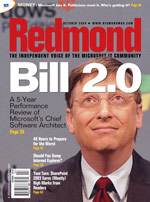 As a 100 percent independent publication, Redmond magazine can take chances. The fact is, all independent magazines can take chances, but conservative publishers and editors usually shy away from doing so. They're either afraid to take up challenges or just boring. I've never been that way. And with full support from my boss, Henry Allain, Redmond marches to a different drummer. We tweak noses, write unusual cover stories and make fun of ourselves.
As a 100 percent independent publication, Redmond magazine can take chances. The fact is, all independent magazines can take chances, but conservative publishers and editors usually shy away from doing so. They're either afraid to take up challenges or just boring. I've never been that way. And with full support from my boss, Henry Allain, Redmond marches to a different drummer. We tweak noses, write unusual cover stories and make fun of ourselves.
Our very first cover story is a case in point. "Bill 2.0" analyzed Bill Gates' five-year tenure as chief software architect. We gave the brilliant Mr. Gates mixed reviews. He probably got better grades at Harvard.
We've made it our mission to have fun ever since. Here are some highlights of the last five years, along with a few predictions for the next five. After 60 issues, there are plenty of great articles to choose from. Here are a few of my favorites.
 "IT Gone Bad" After two dozen lunches with security vendors, I knew everything about protecting a shop against outside hackers or disgruntled employees. But no one seemed to know anything about those who hold the keys to the network: IT pros themselves.
"IT Gone Bad" After two dozen lunches with security vendors, I knew everything about protecting a shop against outside hackers or disgruntled employees. But no one seemed to know anything about those who hold the keys to the network: IT pros themselves.
Our theory is that IT pros are just people -- some good, some bad. So, we asked Redmond readers for tales of IT abusing its power. And, boy, did we get an earful: everything from extortion to theft to good, old-fashioned snooping. CEOs, I learned, are a favorite target.
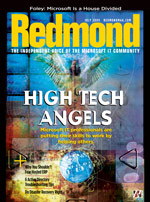 "High-Tech Angels" A couple of years after "IT Gone Bad," we decided to look at "IT Gone Good." Again, we simply asked you, our readers, about your good deeds. It turns out you're pretty decent folks. We wrote about readers like you who donate time and IT expertise to causes from churches and schools to underprivileged kids and the elderly.
"High-Tech Angels" A couple of years after "IT Gone Bad," we decided to look at "IT Gone Good." Again, we simply asked you, our readers, about your good deeds. It turns out you're pretty decent folks. We wrote about readers like you who donate time and IT expertise to causes from churches and schools to underprivileged kids and the elderly.
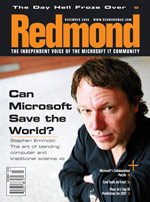 "Can Microsoft Save the World?" To many, Microsoft is an evil software empire, the manifestation of every bad thing Karl Marx predicted would happen. Bunk. There's a little-talked-about side to Microsoft: the money it spends on and the time it devotes to great causes, never expecting a financial reward or a word of thanks. Microsoft Research has its top minds working to fight disease, hunger and pollution -- and unraveling the mysteries of the universe.
"Can Microsoft Save the World?" To many, Microsoft is an evil software empire, the manifestation of every bad thing Karl Marx predicted would happen. Bunk. There's a little-talked-about side to Microsoft: the money it spends on and the time it devotes to great causes, never expecting a financial reward or a word of thanks. Microsoft Research has its top minds working to fight disease, hunger and pollution -- and unraveling the mysteries of the universe.
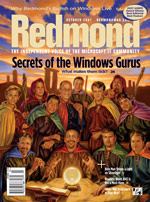 "Secrets of the Windows Gurus" Redmond has always loved entrepreneurs and third parties. These men and women succeed or fail based on the strength of their ideas and will to excel. We always wondered what makes these folks tick and where their ideas come from, so we asked a dozen of the best and brightest and got some smart answers. Some go for a run; others sip whiskey or take a long drive. Even reading history can inspire. And nearly all did the same brilliant thing -- they talked to customers!
"Secrets of the Windows Gurus" Redmond has always loved entrepreneurs and third parties. These men and women succeed or fail based on the strength of their ideas and will to excel. We always wondered what makes these folks tick and where their ideas come from, so we asked a dozen of the best and brightest and got some smart answers. Some go for a run; others sip whiskey or take a long drive. Even reading history can inspire. And nearly all did the same brilliant thing -- they talked to customers!
 "The Strength to Endure" When the economy slumped and Microsoft earnings dipped, critics crawled out of the woodwork claiming that the Redmond giant would fall like Goliath. At Redmond, we've heard the doom and gloom before, and Microsoft has always come out on top. So we penned an essay looking at Microsoft's intrinsic strengths and concluded that the company would be just fine.
"The Strength to Endure" When the economy slumped and Microsoft earnings dipped, critics crawled out of the woodwork claiming that the Redmond giant would fall like Goliath. At Redmond, we've heard the doom and gloom before, and Microsoft has always come out on top. So we penned an essay looking at Microsoft's intrinsic strengths and concluded that the company would be just fine.
Interestingly enough, recent research shows that the move to virtualization and the need to save money are actually boosting Windows Server sales and curtailing Linux.
 "Unfair Fight?" Lest you think Redmond is nothing but a Microsoft apologist, we offer Exhibit A: our story about how Microsoft competes with third parties. Being as close to third parties as we are, we saw case after case where a small company pioneered a market and solved a huge problem for Microsoft, only to have Microsoft force its way into the company's market. Security, administration and management are all examples of this trend.
"Unfair Fight?" Lest you think Redmond is nothing but a Microsoft apologist, we offer Exhibit A: our story about how Microsoft competes with third parties. Being as close to third parties as we are, we saw case after case where a small company pioneered a market and solved a huge problem for Microsoft, only to have Microsoft force its way into the company's market. Security, administration and management are all examples of this trend.
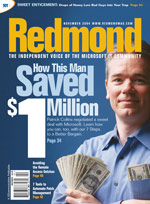 "How This Man Saved $1 Million" We know that IT pros love to hear about technology. But when it comes down to it, top IT folks run an internal business. Lowering costs is not just a priority -- it's job security. We've done a couple of major pieces that help you cut a better deal with your Redmond rep, including a hard-hitting analysis of Software Assurance (SA). Our conclusion? SA only makes sense for the largest customers with the discipline to fully use all of its benefits.
"How This Man Saved $1 Million" We know that IT pros love to hear about technology. But when it comes down to it, top IT folks run an internal business. Lowering costs is not just a priority -- it's job security. We've done a couple of major pieces that help you cut a better deal with your Redmond rep, including a hard-hitting analysis of Software Assurance (SA). Our conclusion? SA only makes sense for the largest customers with the discipline to fully use all of its benefits.
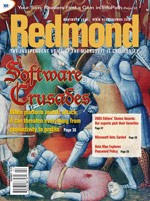 "Software Crusades" We may write about Microsoft, but we aren't zealots. Linux, OpenOffice.org and the Mac have all received thousands of kind words. While we try to be impartial, it's impossible to ignore the fervor of many technology loyalists. Talk to my kids about the Mac, and the passion is evident. Today, open source lovers have the same commitment once shown by Amiga and OS/2 users.
"Software Crusades" We may write about Microsoft, but we aren't zealots. Linux, OpenOffice.org and the Mac have all received thousands of kind words. While we try to be impartial, it's impossible to ignore the fervor of many technology loyalists. Talk to my kids about the Mac, and the passion is evident. Today, open source lovers have the same commitment once shown by Amiga and OS/2 users.
You have to admire the feelings, but these views can stir debate and strife in IT shops and ultimately affect the products enterprises choose.
Reader Reviews: We also pioneered a new type of story, the Reader Review. Here, we come up with a list of criteria, just as any lab would, except we ask you, the Redmond reader, for your findings. The result is an elaborate look at a product based on the real-world experiences of a dozen-plus IT pros.
The Most Important Item: Your advice has fueled nearly all of our cover stories.
The Next Five Years
The last five years have been wilder and woollier than Khalid Sheikh Mohammed. The next five will be promising, but also fraught with challenges.
Microsoft lives in two worlds. Most of its money comes from fat clients such as Windows Vista and Office, and on-premises server operating systems and apps. But listen to the speeches, and all you hear is the Web, clouds and the Internet. Microsoft needs to balance these two forces and serve these two markets. Here's how it may all play out.
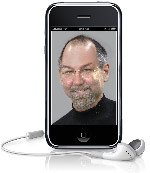 Client Futures: Pundits and loud-mouth CEOs for years have pushed thin clients. The ultimate thin client relies on the Internet and is more or less a dumb terminal with nice graphics. That never really took off. We still buy machines loaded with Windows, Mac OS X or Linux, none of which is truly thin. But still, pundits and loud-mouth CEOs continue to push thin clients, only this time it's just the apps and data that are remote.
Client Futures: Pundits and loud-mouth CEOs for years have pushed thin clients. The ultimate thin client relies on the Internet and is more or less a dumb terminal with nice graphics. That never really took off. We still buy machines loaded with Windows, Mac OS X or Linux, none of which is truly thin. But still, pundits and loud-mouth CEOs continue to push thin clients, only this time it's just the apps and data that are remote.
This change in argument gives Microsoft a pass. Redmond can sell full-featured desktop operating systems while at the same time weaving a compelling Web story. Now, for Microsoft, a thin client is a full client delivered from a server -- usually to a full-featured PC.
On the apps side, programs can come from an enterprise server or increasingly be hosted in a Microsoft cloud. The software is much the same; only the delivery has changed. Microsoft is also helping us store our data remotely, all the while communicating with a good old-fashioned fat PC.
 The Cloud Rises: Microsoft's cloud plan is something old and something new. That makes sense. I believe that Azure, the overarching cloud architecture, offers a somewhat smooth transition from on-premises Microsoft infrastructure to the cloud. Yeah, it's a lot of work, and it takes some serious programming resources, but you aren't starting entirely from scratch.
The Cloud Rises: Microsoft's cloud plan is something old and something new. That makes sense. I believe that Azure, the overarching cloud architecture, offers a somewhat smooth transition from on-premises Microsoft infrastructure to the cloud. Yeah, it's a lot of work, and it takes some serious programming resources, but you aren't starting entirely from scratch.
If you know .NET programming, you have a leg up. Work with SQL Server? Move to the front of the line. You can count me as bullish on Azure.
Web Apps Take Hold: The real challenge is making Web apps truly work with what's stuck on your hard drive. Microsoft's killer app will be one that syncs your laptop with all your other laptops, desktops and phones. So far, I haven't seen it.
 Can You Say ERP?: I've never found ERP software to be terribly exciting, but I know that companies need it and that vendors make a lot of money from it. It's no wonder that Microsoft got into the business. But it entered in a strange way, buying no fewer than four ERP platforms: Solomon, Axapta, Navision and Great Plains, plus a separate customer relationship management tool.
Can You Say ERP?: I've never found ERP software to be terribly exciting, but I know that companies need it and that vendors make a lot of money from it. It's no wonder that Microsoft got into the business. But it entered in a strange way, buying no fewer than four ERP platforms: Solomon, Axapta, Navision and Great Plains, plus a separate customer relationship management tool.
 This isn't the ideal way to compete with SAP or Oracle, but Microsoft is beginning to make it work. Just as it takes eons to install an ERP system, it takes even longer to really build a market position. In five years, I predict Microsoft will be a huge player.
This isn't the ideal way to compete with SAP or Oracle, but Microsoft is beginning to make it work. Just as it takes eons to install an ERP system, it takes even longer to really build a market position. In five years, I predict Microsoft will be a huge player.
The Role of Ray: When Ray Ozzie joined Microsoft -- and Redmond buying Ozzie's Groove had a little to do with it -- many thought he would be a short-timer. That was four years ago. As an impartial observer, I see Ozzie staying with Microsoft for at least five more years. The man has at least that much to accomplish. I think these will be five amazingly fruitful years.
Anyone who has ever sat down with Ozzie, or used his software, knows that he has the stuff to compete with Google, IBM or anyone else who comes down the pike.
Innovation Station: With Altair Basic, Microsoft helped launch the PC industry. DOS, Windows and Office helped turned these machines into indispensable business tools.
But can Microsoft once again invent the future?
Yes, it can. Microsoft Research spends billions of dollars a year working on ideas that may or may not turn into products. And Microsoft's paranoia and near-insane motivation insure that it will fight to build products that will keep it in the lead. And, Microsoft has Ozzie.
Would you bet against Microsoft? Lay your money down by e-mailing me at [email protected].